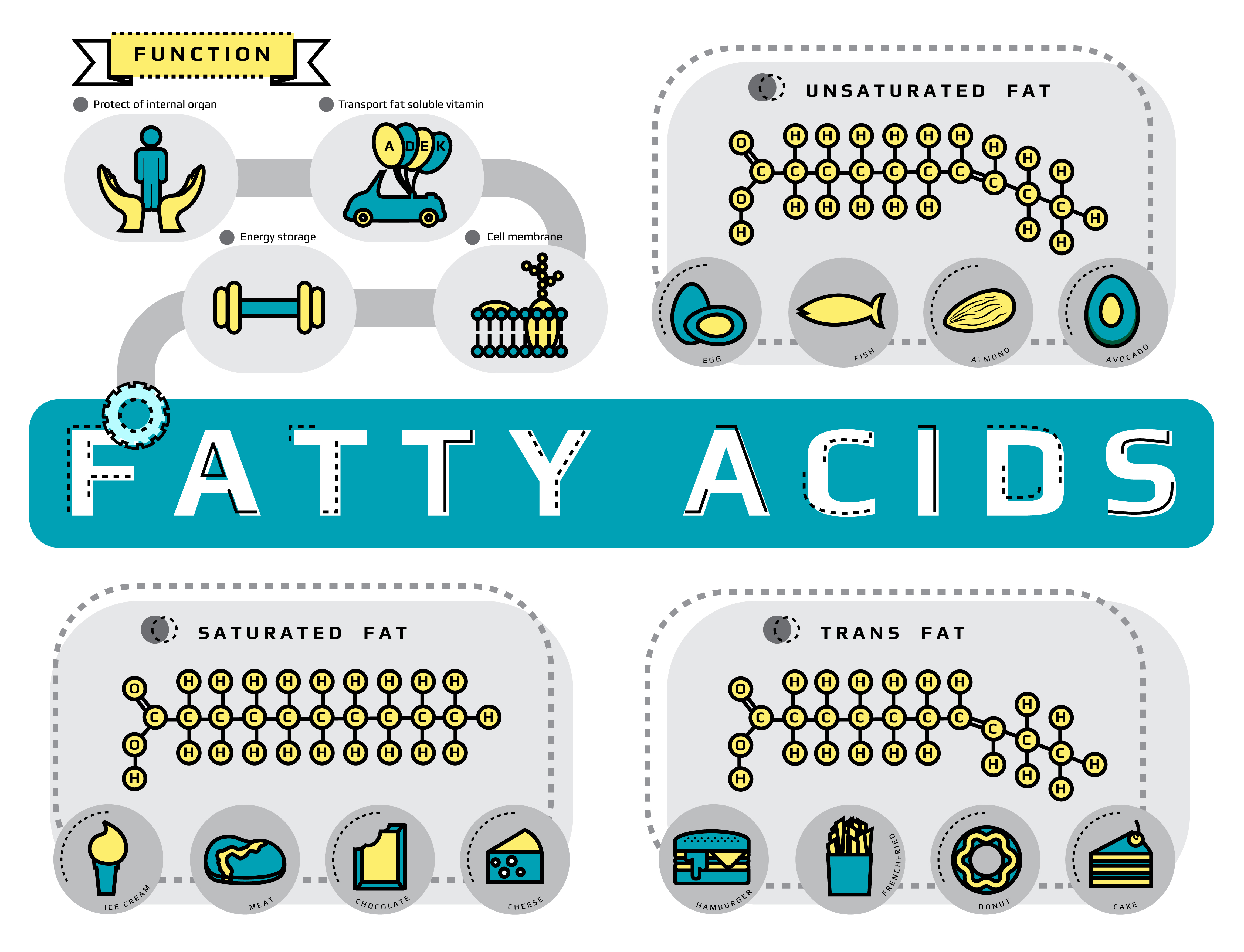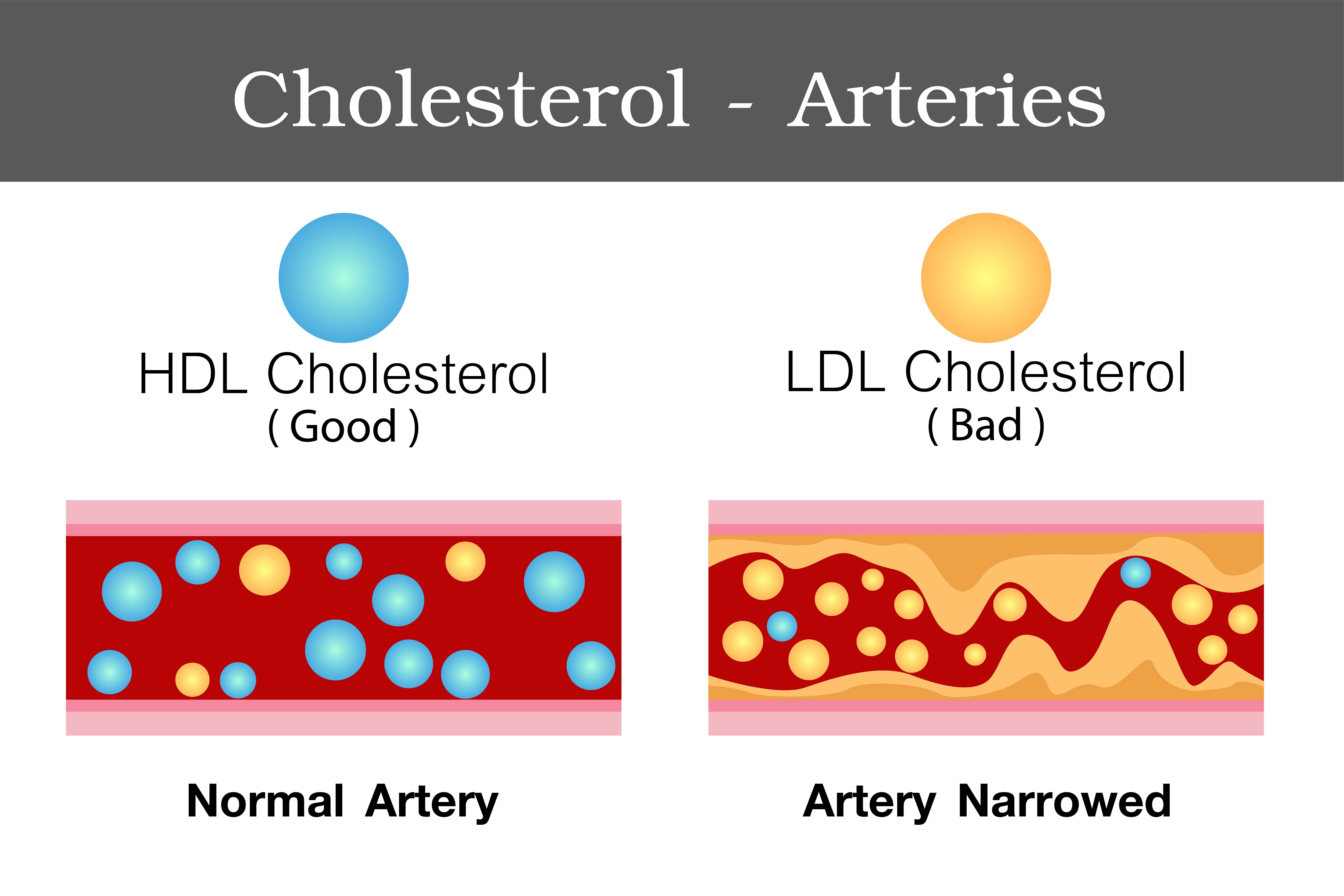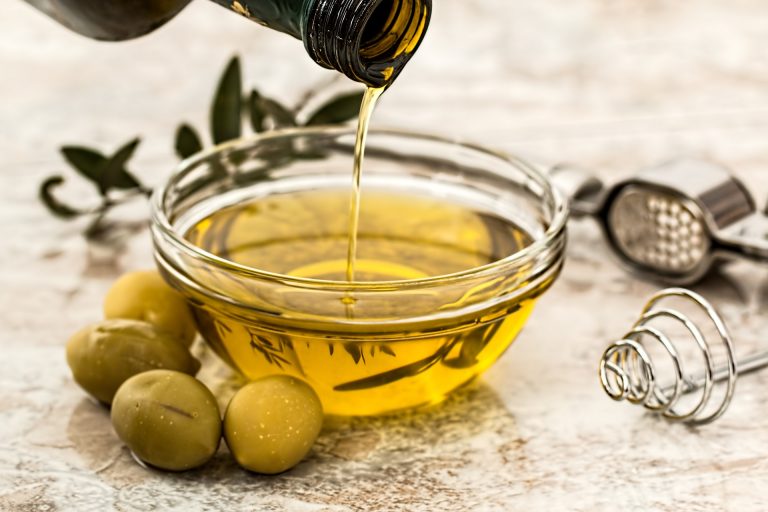What is a ‘good’ fat? What is a ‘bad’ fat? You would be forgiven for being confused. We are constantly bombarded with advice and guidance on what type of fat we should or shouldn’t be eating, even whether we should be eating fat at all! This article will try to separate the fact from the fiction and explain the science behind what fat is, how it is used in the body and what type of fats are better for our health than others, and the best foods to eat to ensure we consume enough fat for good health.
Lipids and their functions in the body
What are lipids? Lipid is the chemical name for fat, and can be used interchangeably. Lipids have many functions in the body and are essential for good health.
- Lipids are a concentrated source of energy with 1 g of fat releasing 37 kJ of energy (or 9 kcal)
- Lipids are stored in adipose tissue (fat cells) for times of energy need.
- Lipids consumed in our food prolong the feeling of being full as they delay emptying of the stomach
- They transport and store fat soluble vitamins – A, D, E and K
- They are an important constituent for the synthesis of cellular structures and signalling molecules
- Insulate neurons by providing a protective fatty sheath around them called myelin
- Cholesterol is a lipid that is an important cell membrane component and required for the synthesis of certain hormones
- Lipids play a role in protecting some internal organs, but this is controversial, as visceral fat can become a health hazard in excess and we are encouraged to decrease visceral fat levels for good health.
Types of fatty acids
You have probably heard about saturated fats and unsaturated fats, but what makes a fat saturated or not and what does this really mean for our health? It’s all about the chemical structure of the lipid molecule and how this structure determines the relative ‘healthiness’ of the fat in question.
The major dietary lipids in our food are called triacylglycerol's which are contained in fats and oils. Triacylglycerol molecules are made up of three fatty acid molecules and one glycerol molecule joined together. These fatty acids are chains of carbon atoms each connected to a maximum of two hydrogen atoms. Where a carbon atom is connected to one hydrogen atom then it has a double bond. The double bond creates a so call ‘kink’ in the chain, preventing triacylglycerol molecules from packing closely together.
The more the double bonds in a fatty acid chain the less packed the molecules are – it is known as an unsaturated fatty acid. The less packing the more liquid the lipid it, the more packed the more solid the lipid it. If a triacylglycerol molecule has no double bonds it is said to be saturated. Fatty acids with one double bond are known as monounsaturated and those with many double bonds are known as polyunsaturated. We cannot make fatty acids with double bonds in our body, so must obtain them from our diet. Dietary saturated fats tend to be solid, such as lard and butter, unsaturated fats tend to be liquid such as olive oil.

Reading the labels!
If you read the label on a foodstuff, you will see that fat content is listed by type. For example, you will see total fat content usually per 100g of foodstuff, then this level is usually broken down into saturates, monounsaturates and polyunsaturates. The lower the level of statured fat usually the healthier the product is or at least healthy with regard to type of fat in the product. If you are on a diet and want to reduce calories, then it is advisable to choose foodstuffs with higher proportions of polyunsaturated fats than saturated fats. This is because polyunsaturated fats are less dense than saturated fats for the same volume, and hence contain fewer calories.
But consuming ‘good’ fats (unsaturated fats) is not just about calories. Unsaturated fats are grouped into three series known as omega-3, omega-6 and omega-9. The pattern of unsaturation is important for health. A diet rich in polyunsaturated omega-3 fatty acids from oily fish such as salmon, herring and mackerel is linked to a low incidence of heart disease. Omega-6 fatty acids are more prevalent in our diet and are present in foodstuffs such as, poultry, most vegetable oils, wholegrains, nuts, cereals and durum wheat. Oleic acid is the main omega-9 fatty acid, and is found in olive oil and nuts (especially peanuts and walnuts) key components of the ‘healthy’ Mediterranean diet.
Omega-3
Omega-3 can occur in foodstuffs in three different forms.
- α-linolenic acid (ALA), a short chain fatty acid, which can be found in plant based foods
- eicosapentaenoic acid (EPA), a long chain fatty acid found in oily fish
- docosahexaenoic acid (DHA), a long chain fatty acid found in oily fish
As a vegetarian the only type of omega-3 that can be consumed is ALA, obtained from plant based oils such as flaxseed/linseed, hempseed oil and rapeseeds oil. Long chain fatty acids EPA and DHA are normal components of brain and retinol membranes. Long chain omega-3 fatty acids are prevalent in fish oil and can be made in the body from shorter chain varieties such as ALA, but in practice there is limited conversion to EPA and very little to DHA in humans. It is therefore important that vegetarians and vegans consume plant based oils such as linseed to ensure they are meeting their daily needs. Non-vegetarians should include two portions of fish in their diet per week, one being an oily fish.

Cholesterol and heart health
Cholesterol is an important lipid in the body because it is a key component of cell membranes, signalling between cells and for the synthesis of some hormones. It is synthesised in the liver, but can also be consumed in the diet. Our body regulates cholesterol levels to ensure they stay at healthy levels, however sometimes our blood cholesterol levels become too high and can lead to various health conditions.
Cholesterol is transported in our blood attached to specific protein molecules. These so called lipoproteins move lipids around the body. There are various different forms of lipoproteins but the ones of main focus are low-density lipoproteins (LDLs) and high-density lipoproteins (HDLs). The ratio of HDL to LDL is associated with risk of atherosclerosis (deposits of fat in the arteries leading to blocked arteries). The greater the proportion of HDL the lower the risk. Unsaturated fatty acids increase the proportion of HDL and thereby lower blood cholesterol levels, whereas saturated fatty acids increase the proportion of LDL and raise blood cholesterol levels.
Blocked arteries can cause an increase in blood pressure because blood is unable to flow easily through narrowed arteries so the heart works harder. Blocked arteries also cause a lack of oxygenated blood and glucose reaching body tissue. When this happens in the coronary arteries to heart muscle then heart tissue dies or it causes an ischaemic attack – oxygen lacking pain. Angina can also be felt upon exercising because the heart muscle is not receiving the oxygen and glucose it needs due to the narrowing or blocking of coronary arteries. When many coronary arteries are blocked a heart attack can occur. A blocked artery to the brain can cause a stroke.

Conclusions
Bad fats are in essence saturated fats. Saturated fats are found usually in hard animal based fats such as butter and lard, and where these fats might be used such as in ready meals, sauces, pastry etc. They obviously naturally occur in animal products such as lamb, beef, other red meats, so overconsumption of these meats can increase saturated fat intake. Whilst animal fats can taste nice, it’s important to not over consume them in order to keep LDL cholesterol to a minimum and therefore reducing risk of heart disease and stroke.
Good fats are largely plant based, they are unsaturated fats and can be found in olive oil, rapeseed oil, flaxseeds, linseed oil, oily fish such as salmon, herring and mackerel. Goods fats increase the proportion of HDL cholesterol in the blood and this is known to lower risk of heart disease and stroke as a result of narrowing or blocked arteries.
Fat is a great source of energy, helps us to absorb and store fat based vitamins and it essential for many bodily functions, so should not be eliminated from the diet. It should be consumed in small amounts and of the healthiest type – unsaturated fats. Our body likes to store fat, so overconsumption will make you fat, but it’s also key to know that our body will convert too much carbohydrate into fat and store that too! So to stay healthy don’t overconsume fats or carbohydrates, eat the right sorts in moderation and exercise on a regular basis!
Reference:
Webb, G. P. (2012). Nutrition. Maintaining and improving health. (Fourth ed.). London. Hodder Arnold






